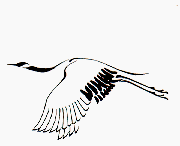
FOREST MANAGEMENT
GUIDELINES FOR MICHIGAN
By the Michigan Society of American Foresters
WILDLIFE HABITAT
Forest management practices are a key to managing wildlife habitat and populations. These practices can produce the diversity of vegetation types required by numerous wildlife species that depend on specific forest stand conditions to meet their life requisites. Various management strategies, including the application of even-aged and uneven-aged silvicultural techniques or simply not manipulating stands (i.e. no harvesting) provides a variety of stand ages, tree sizes, and plant species composition.
Maintaining a diversity of tree species within and among stands can be important in maintaining the biodiversity associated with forest ecosystems. Size, timing, shape, and juxtaposition of timber harvesting can be critical for maintaining selected featured wildlife species or a diversity of species. Because of the ability to set back succession with various silvicultural techniques, timber harvesting is an essential component for managing many types of wildlife, especially game species.
 To
increase the beneficial effects of forest management for wildlife, landowners
need to consider and provide the specific food, cover space, and reproductive
conditions for species. These requirements may be provided by considering some
of the following components when developing a forest management plan. Landowners
must also recognize that management for one species may produce unfavorable
conditions for other species.
To
increase the beneficial effects of forest management for wildlife, landowners
need to consider and provide the specific food, cover space, and reproductive
conditions for species. These requirements may be provided by considering some
of the following components when developing a forest management plan. Landowners
must also recognize that management for one species may produce unfavorable
conditions for other species.
Increase or Decrease Amount of Edge:
Induced edges occur between different age classes of forest stands and are essential to some wildlife species. Natural resource managers create more edge in forests by developing a diversity of age classes in a forest type.
When landowners' objectives require the creation of edges for wildlife, cut back the forest borders around fields and wildlife food plots.
Other wildlife species, however, do better in larger tracts of a forest type of one age class, and therefore, landowner's objectives must be considered prior to timber harvesting.
 Planting,
Seeding, and Fertilization:
Planting,
Seeding, and Fertilization:
Landowners may desire to enhance the development of vegetation by planting, seeding, and/ or fertilizing.
Log landings and other open or disturbed areas may be seeded with perennial grasses or selected shrub species may be planted that provide benefits to wildlife for food and/or cover.
When considering planting or seeding as a method to enhance wildlife habitat, landowners should consider native plant species which are well adapted to the site conditions and climate.
Fertilization as a method to enhance plant growth should be used with caution since the application of additional nutrients may make plants more palatable to herbivores (e.g. deer, rabbits) and, therefore, may make it difficult to establish them. Fertilization may also adversely affect plant species (and thus associated wildlife species) that are adapted to nutrient poor sites. Consider consulting the Michigan Department of Natural Resources staff before planting, seeding, or fertilization projects are undertaken.
Snags and Dead and Downed Woody Material:
When developing a forest management plan it is important to consider leaving some snags and dead and downed woody material.
Snags are the dead, standing trees that typically make up approximately 5% to 10% of a forest. Snags will provide habitat for many wildlife species including woodpeckers and raccoons.
Decaying logs and stumps also provide habitat for wildlife species and provide favorable regeneration sites for certain plant species and trees.
Leave Mast Producing Trees:
In stands that are to be clearcut and selectively harvested, retain mast producing trees such as oaks, beeches, and hickories that provide wildlife foods.
Retain Mature Cedar and Hemlock:
Mature stands of northern white cedar and hemlock provide critical winter cover for species such as white-tailed deer in Michigan and important year-round habitat for other wildlife species such as songbirds. Small inclusions of conifers in hardwood stands can also increase the number of wildlife species that will use an area.
 Regeneration
of Aspen:
Regeneration
of Aspen:
The maintenance of various age classes of aspen and other deciduous species, especially near wintering areas, is important as a wildlife food source for herbivores. These dense, regenerating stands provide abundant food during the winter as well as dense nesting, hiding, and brood cover during the spring and summer for many bird species.
Maintain Small Ponds at Natural Seeps and Springs:
These critical areas may provide important habitat components such as food and cover for many wildlife species including salamanders, frogs, and eastern wild turkeys.
Road Closures:
Consider closing roads to vehicles until the next timber harvesting. Reducing vehicle access will protect species, such as black bear, which can benefit from timber harvesting but may be negatively affected by increased access.
Maintain Diverse Forest Conditions Across Michigan's Landscape:
Maintaining a broad range of age classes of all Michigan's forest habitat types of various sizes is important for the state's biodiversity. Some wildlife species, such as ruffed grouse, require relatively young trees while other species (woodpeckers and other cavity nesting birds and black bears) require older trees to meet some of their habitat needs. In providing these habitat conditions, natural resource managers should attempt to use harvest regimes that emulate natural disturbance patterns.
Know Objectives of Adjacent Landowners:
Landowners should investigate wildlife habitat conditions and objectives for adjacent lands. Many wildlife species are dependent on habitat conditions across large land areas. Coordinating forest management practices among multiple landowners will enhance the types of wildlife habitat that can be provided across the state. Check with local officials to determine if any regional planning groups exist in your area. Consult these groups for opportunities to participate in land management partnerships.
Rare, Endangered and Threatened Species:
Because of the diversity of forest habitat types throughout Michigan, there are many rare, endangered, and threatened species of plants, insects, reptiles, amphibians, birds, and mammals associated with these types. Maintaining Michigan's diverse habitat conditions will help conserve these species.

This website is maintained by Bill Cook, Michigan State University Extension
Forest in the Upper Peninsula. Comments, questions,
and suggestions are gratefully accepted.
Last update of this page was 8 May, 2008
This site is hosted by School of Forest Resources and Environmental Science at Michigan Technological University.